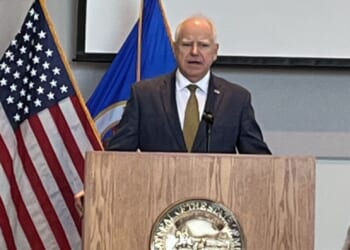Lawmakers pass a bill to end the ban on large nuclear plants but include plans on expanding state control over energy.
Illinois lawmakers have passed Senate Bill 25, a sweeping energy bill that ends the state’s 40-year moratorium on large-scale nuclear plants, but also extends state control over how energy is produced and managed.
This measure also adds cost increases for consumers including $7 billion for battery storage projects beginning in 2030 according to the Illinois Manufacturers’ Association.
The proposal, set to be signed into law on Nov. 6 by Gov. J.B. Pritzker, introduces new layers of bureaucracy that threaten to increase energy prices and undercut the benefits of nuclear expansion.
While lifting its nuclear ban is a positive step towards competitiveness and reliability, new state mandates risk driving up costs for residents and businesses and slowing innovation.
Positive developments
Ending Illinois’ decades-long nuclear ban is a much-needed step toward energy independence and affordability. The new law would allow construction of reactors larger than 300 megawatts, expanding on the state’s elimination of a ban on smaller reactors in 2023.
Illinois already gets 54% of its electricity from six nuclear power plants and 11 reactors, making it one of the most nuclear reliant states in the nation. With a spike in interest in nuclear energy in recent years with the development of AI and quantum computing, lifting its moratorium positions Illinois to remain a leader in reliable, zero-emission power, while adding a necessary foundation for economic growth because many industries will see their energy needs increase in the coming years.
The bill also takes steps to streamline permitting processes and curb local obstruction. Now counties have 60 days to approve or deny energy-storage permits. If a consensus is not reached, the permit is automatically approved. It also set limits on local municipalities to demand property-value guarantees, impose extended approval timelines, excessive fees or set overly strict environmental or safety rules.
Concerns
Despite these positive steps, the proposal also expands bureaucracy and regulation that risk higher costs and slower innovation.
The bill expands state control of energy by directing the Illinois Commerce Commission to oversee long-term energy planning through new Integrated Resource Plans. Utility companies must project energy demand 5 to 20 years out and include detailed modeling on emissions, affordability, equity, and grid reliability. The Commission has some power to revise or reject plans to meet demands. Utilities can recover IRP related costs by excluding them from rate-cap calculations, potentially increasing short-term rates. This will add layers of regulations for utility companies to navigate.
The legislation also creates numerous programs and departments that will require either budgetary allocations from the state or costs on companies or consumers, or some combination thereof, including:
- The Thermal Energy Network Pilot Program: Administers $20 million for thermal network projects.
- Geothermal Homes and Businesses Program: Allocates $10 million per year in credits for installation of new geothermal heating and cooling systems.
- Powering Up Illinois: mandates faster utility connections for EV infrastructure and establishes performance standards.
- Energy Reliability Corporation of Illinois: This entity will study the feasibility of state-specific independent System Operator to manage Illinois’ electric grid.
The Illinois Manufacturers’ Association estimates added costs from the bill could mean “a small food processor using 1,400kW of energy will see a monthly rate increase of $1,466 in the first year, which will grow to an increase of $12,084 in 2045 – a $144,000 annual increase. A large auto manufacturer using 10,100kW will see a first-year monthly rate increase of $11,361, which rises to a monthly increase of $87,276 per month in 2045 – a hike of $1,047,312 each year.”
Overall, these initiatives can potentially add further regulatory burdens and introduce new fiscal costs at a time when Illinois already faces high tax burdens and recurring budget deficits. Overly strict rules can undercut Illinois’ goal of cheap and efficient energy by limiting production and adding costs which would be passed on to ratepayers.
While lifting the nuclear moratorium is a win for reliability and innovation, higher state control and added regulations risk undoing those gains. Illinois should embrace policies that make energy cheaper, cleaner and more dependable through competition and regulatory restraint, not deeper political control.
Nuclear power can strengthen Illinois’ economy, but only if Springfield learns to get out of its way.











